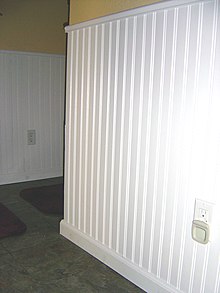
39-inch (1 m) wainscoting using 3-inch (76 mm) tongue and groove pine boards.
Panelling is a wall covering constructed from rigid or semi-rigid components. These are traditionally interlocking wood, but could be plastic or other materials.
Panelling was developed in antiquity to make rooms in stone buildings more comfortable. The panels served to insulate the room from the cold stone. In more modern buildings, such panelling is often installed for decorative purposes. Panelling, such as wainscoting and boiserie in particular, may be extremely ornate and is particularly associated with seventeenth and eighteenth century interior design, Victorian architecture in Britain, and its international contemporaries.
Wainscot panelling[]
Wainscot or wainscoting (pronounced UK: /ˈweɪnskət/, US: /ˈweɪnskɒt/, Template:USdict) is a paneling style applied to the lower 3' (900mm) to 5' (1500mm) of an interior wall, below the dado rail or chair rail and above the baseboard or skirting board. It is traditionally constructed from tongue-and-groove boards, though beadboard or decorative panels (such as a wooden door might have) are also common. New manufacturing techniques are capable of milling large panels from one sheet which reduce seams, caulking and expansion/contraction cracks which have plagued traditional construction. Wainscoting may also refer to other materials used in a similar fashion.
The original purpose of wainscoting was to cover the lower part of walls which, in houses constructed with poor or nonexistent damp-proof courses, are often affected by rising dampness. Its purpose is now decorative.
Boiserie[]

Elaborate boiseries in the guild hall of the Zunfthaus zu Kaufleuten, Kramgasse 29, Berne.
Boiserie (often used in the plural boiseries) is the term used to define ornate and intricately carved wood panelling. Early examples of boiseries were unpainted, but later the raised mouldings were often painted or gilded. Boiseries were popular in seventeenth and eighteenth century French interior design and the Palace of Versailles has many fine examples. The panels were not confined just to the walls of a room but were also used to decorate doors, frames, cupboards and shelves. Often pictures would be set into the boiseries, the carving framing the picture rather like a conventional frame.
See also[]
- Ornament (architecture)
- Molding (decorative)
- Vacuum insulated panel
- Structural insulated panel
Notes[]
| This article does not cite any references or sources. Please help improve this article by adding citations to reliable sources. Unsourced material may be challenged and removed. (January 2008) |
This page is being imported from Wikipedia, to create a Wikidwelling stub or article. These steps need to be completed:
The original article was at Panelling. The list of authors can be seen in the history for that page. The text of Wikipedia is available under the CC-BY-SA 3.0 license. |
de:Täfelung
it:Boiserie
nn:Panel
sv:Panel
pt:apainelamento
